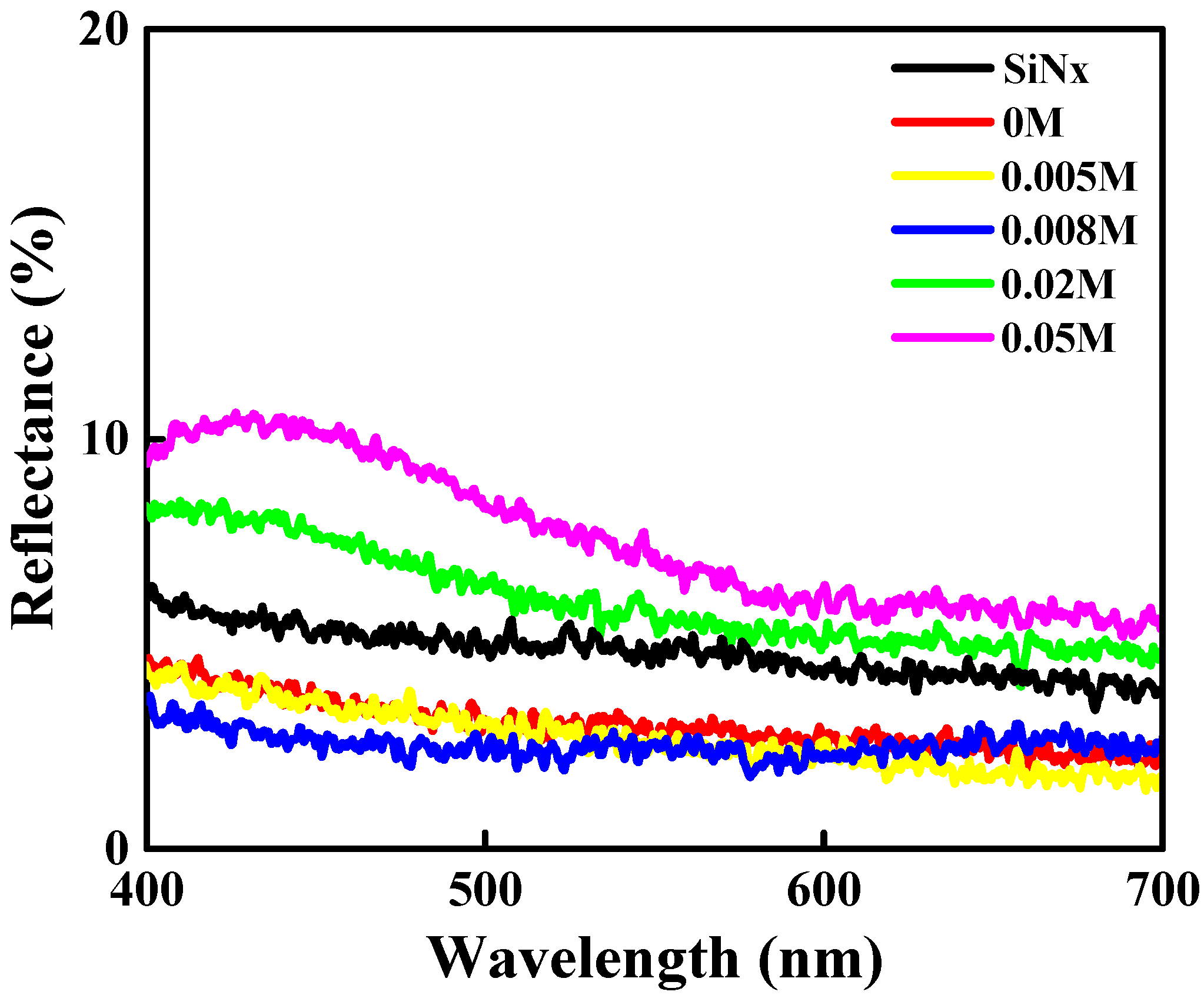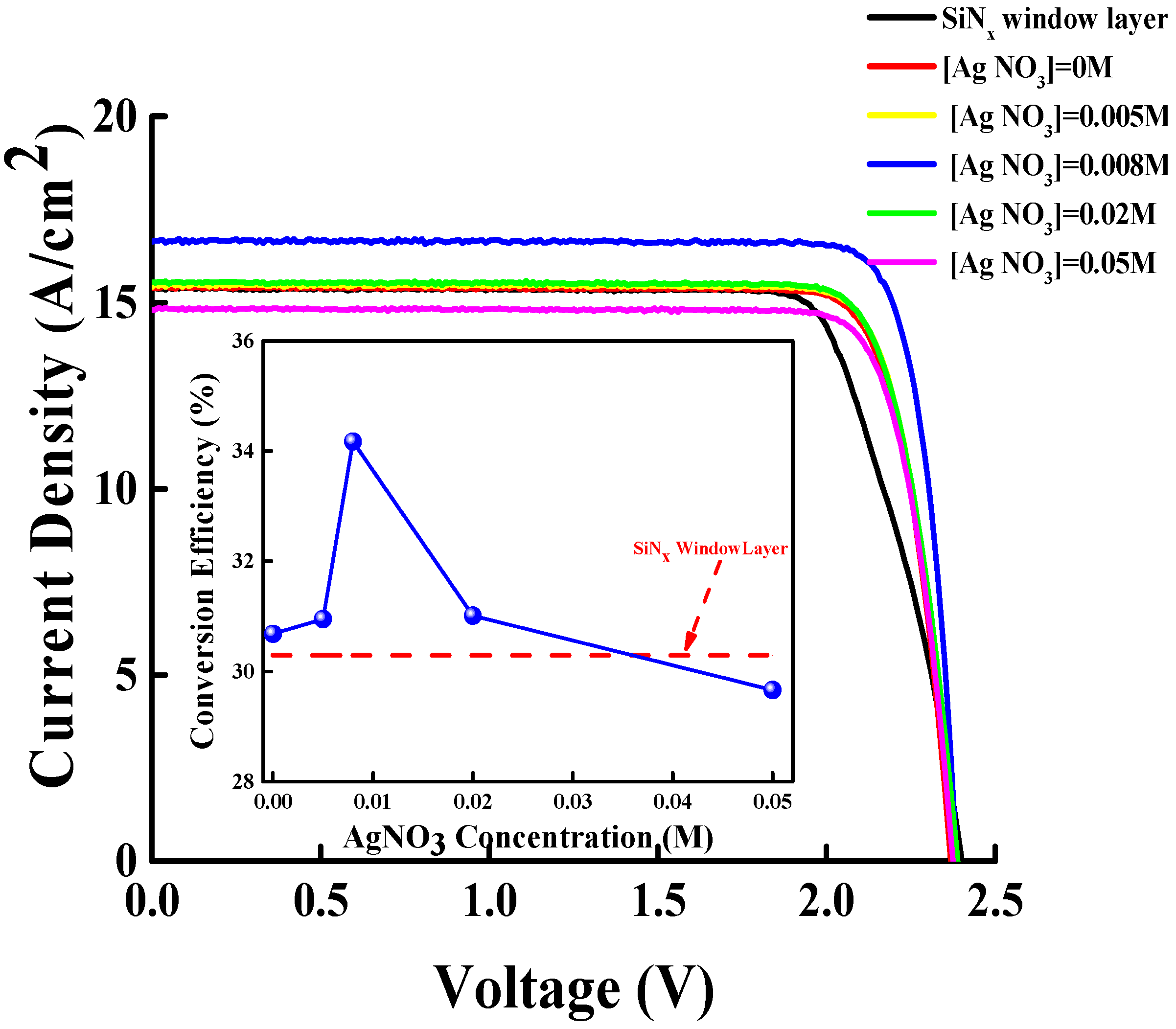Using Spin-Coated Silver Nanoparticles/Zinc Oxide Thin Films to Improve the Efficiency of GaInP/(In)GaAs/Ge Solar Cells
Abstract
:1. Introduction
2. Results and Discussion
3. Experimental Details
3.1. Deposition of the Ag NP/ZnO Thin Film
3.2. Fabrication of GaInP/GaAs/Ge Solar Cells with an Ag NP/ZnO Window Layer
4. Conclusions
Author Contributions
Funding
Conflicts of Interest
References
- Luque, A.; Hegedus, S. Handbook of Photovoltaic Science and Engineering; John & Wiley: New York, NY, USA, 2003; p. 359. [Google Scholar]
- Green, M.A.; Emery, K.; Hishikawa, Y.; Warta, W.; Dunlop, E.D. Solar cell efficiency tables (version 47). Prog. Photovolt. Res. Appl. 2016, 24, 3–11. [Google Scholar] [CrossRef]
- Nelson, J. The Physics of Solar Cells; Imperial College Press: London, UK, 2003; p. 198. [Google Scholar]
- Faucher, J.; Sun, Y.; Jung, D.; Martin, D.; Masuda, T.; Lee, M.L. High-efficiency AlGaInP solar cells grown by molecular beam epitaxy. Appl. Phys. Lett. 2016, 109, 172105. [Google Scholar] [CrossRef]
- Polojarvi, V.; Aho, A.; Tukiainen, A.; Schramm, A.; Guina, M. Comparative study of defect levels in GaInNAs, GaNAsSb, and GaInNAsSb for high-efficiency solar cells. Appl. Phys. Lett. 2016, 108, 122104. [Google Scholar] [CrossRef]
- Sugaya, T.; Nagato, Y.; Okano, Y.; Oshima, R.; Tayagaki, T.; Makita, K.; Matsubara, K. Growth of InGaAsP solar cells and their application to triple-junction top cells used in smart stack multijunction solar cells. J. Vac. Sci. Technol. B 2017, 35, 02B103-1–02B103-5. [Google Scholar] [CrossRef]
- Tiwari, B.; Hossain, M.J.; Bhattacharya, I. GaP/InGaAs/InGaSb triple junction current matched photovoltaic cell with optimized thickness and quantum efficiency. Sol. Energy 2016, 135, 618–624. [Google Scholar] [CrossRef]
- Hashem, I.E.; Carlin, C.Z.; Hagar, B.G.; Colter, P.C.; Bedair, S.M. InGaP-based quantum well solar cells: Growth, structural design, and photovoltaic properties. J. Appl. Phys. 2016, 119, 095706. [Google Scholar] [CrossRef] [Green Version]
- Dimroth, F.; Tibbits, T.N.D.; Niemeyer, M.; Predan, F.; Beutel, P.; Karcher, C.; Oliva, E.; Siefer, G.; Lackner, D.; Fuß-Kailuweit, P.; et al. Four-junction wafer-bonded concentrator solar cells. IEEE J. Photovolt. 2016, 6, 343–349. [Google Scholar] [CrossRef]
- Sahoo, G.S.; Nayak, P.P.; Mishra, G.P. An ARC less InGaP/GaAs DJ solar cell with hetero tunnel junction. Superlattices Microstruct. 2016, 95, 115–127. [Google Scholar] [CrossRef]
- Özen, Y.; Akın, N.; Kınacı, B.; Özçelik, S. Performance evaluation of a GaInP/GaAs solar cell structure with the integration of AlGaAs tunnel junction. Sol. Energy Mater. Sol. Cell 2015, 137, 1–5. [Google Scholar] [CrossRef]
- Schubert, M.F.; Mont, F.W.; Chhajed, S.; Poxson, D.J.; Kim, J.K.; Schubert, E.F. Design of multilayer antireflection coatings made from co-sputtered and low-refractive-index materials by genetic algorithm. Opt. Exp. 2008, 16, 5290–5298. [Google Scholar] [CrossRef]
- Saylan, S.; Milakovich, T.; Hadi, S.A.; Nayfeh, A.; Fitzgerald, E.A.; Dahlem, M.S. Multilayer antireflection coating design for GaAs0.69P0.31/Si dual-junction solar cells. Sol. Energy 2015, 122, 76–86. [Google Scholar] [CrossRef]
- Tsai, M.T.; Yang, Z.P.; Jing, T.S.; Hsieh, H.H.; Yao, Y.C.; Lin, T.Y.; Chen, Y.F.; Lee, Y.J. Achieving graded refractive index by use of ZnO nanorods/TiO2 layer to enhance omnidirectional photovoltaic performances of InGaP/GaAs/Ge triple-junction solar cells. Sol. Energy Mater. Sol. Cell 2015, 136, 17–24. [Google Scholar] [CrossRef]
- Chang, S.J.; Hou, J.L.; Hsueh, T.J.; Lam, K.T.; Li, S.G.; Liu, C.H.; Chang, S.P. Triple-Junction GaInP/GaAs/Ge Solar Cells with an AZO Transparent Electrode and ZnO Nanowires. IEEE J. Photovolt. 2013, 3, 331–336. [Google Scholar] [CrossRef]
- Kang, E.K.; Yeo, C.I.; Kang, S.J.; Min, J.W.; Song, Y.M.; Lee, Y.T. Improved Light Absorption of GaInP/GaAs/Ge Solar Cell Modules with Micro/Nanoengineered Coverglasses. IEEE J. Photovolt. 2015, 5, 1130–1136. [Google Scholar] [CrossRef]
- Joannopoulos, J.D.; Meade, R.D.; Win, J.N. Photonic Crystals; Princeton University Press: Princeton, NJ, USA, 1995. [Google Scholar]
- Yu, W.J.; Shen, L.; Long, Y.B.; Shen, P.; Guo, W.B.; Chen, W.Y.; Ruan, S.P. Highly efficient and high transmittance semitransparent polymer solar cells with one-dimensional photonic crystals as distributed Bragg reflectors. Org. Electron. 2014, 15, 470–477. [Google Scholar] [CrossRef]
- Saravanan, S.; Dubey, R.S. Optical absorption enhancement in 40 nm ultrathin film silicon solar cells assisted by photonic and plasmonic modes. Opt. Commun. 2016, 377, 65–69. [Google Scholar] [CrossRef]
- Huang, M.J.; Yang, C.R.; Lee, H.S.; Liu, H.L. Fabrication of novel hybrid antireflection structures for solar cells. Sol. Energy 2014, 107, 489–494. [Google Scholar] [CrossRef]
- Luo, Q.; Deng, X.S.; Zhang, C.X.; Yu, M.D.; Zhou, X.; Wang, Z.B.; Chen, X.H.; Huang, S.M. Enhancing photovoltaic performance of perovskite solar cells with silica nanosphere antireflection coatings. Sol. Energy 2018, 169, 128–135. [Google Scholar] [CrossRef]
- Cheng, K.; Jin, R.R.; Liu, J.J.; Liu, X.S.; Liu, J.L.; Lu, Z.B.; Liu, Y.; Guo, L.F.; Du, Z.L. Patterned honeycomb-like ZnO cavities for Cu(In,Ga)Se2 thin film solar cells with omnidirectionally enhanced light harvesting. Sol. Energy Mater. Sol. Cells 2017, 170, 211–218. [Google Scholar] [CrossRef]
- Voroshilov, P.M.; Simovski, C.R.; Belov, P.A.; Shalin, A.S. Light-trapping and antireflective coatings for amorphous Si-based thin film solar cells. J. Appl. Phys. 2015, 117, 203101. [Google Scholar] [CrossRef]
- Wang, P.H.; Nowak, R.E.; Geißendörfer, S.; Vehse, M.; Reininghaus, N.; Sergeev, O.; von Maydell, K.; Brolo, A.G.; Agert, C. Cost-effective nanostructured thin-film solar cell with enhanced absorption. Appl. Phys. Lett. 2014, 105, 183106. [Google Scholar] [CrossRef]
- Wang, Y.Y.; Zhang, R.Y.; Zhang, Z.; Qiu, B.C.; Wang, S.M.; Wu, X.M. Efficiency improvement of GaInP solar cells by broadband omnidirectional antireflection through dielectric composite nanostructures. Sol. Energy Mater. Sol. Cell 2017, 169, 33–39. [Google Scholar] [CrossRef]
- Tong, C.; Yun, J.Y.; Song, H.M.; Gan, Q.Q.; Anderson, W.A. Plasmonic-enhanced Si Schottky barrier solar cells. Sol. Energy Mater. Sol. Cells 2014, 120, 591–595. [Google Scholar] [CrossRef]
- Liu, W.; Wang, X.D.; Li, Y.Q.; Geng, Z.X.; Yang, F.H.; Li, J.M. Surface plasmon enhanced GaAs thin film solar cells. Sol. Energy Mater. Sol. Cells 2011, 95, 693–698. [Google Scholar] [CrossRef]
- Zhou, Z.Q.; Qiu, Y.; Shi, W.; Sun, T.; Li, Y.L.; Lu, M. Surface plasmons on Ag clusters induced via ultrasonic and thermal treatments and the enhancement of Si nanocrystal light emission. Physica E 2014, 64, 63–67. [Google Scholar] [CrossRef]
- Sardana, S.K.; Chava, V.S.N.; Komarala, V.K. Morphology and optical properties of sputter deposited silver nanoparticles on plain, textured and antireflection layer coated textured silicon. Appl. Surf. Sci. 2015, 347, 651–656. [Google Scholar] [CrossRef]
- Mandal, P.; Sharma, S. Progress in plasmonic solar cell efficiency improvement: A status review. Renew. Sustain. Energy Rev. 2016, 65, 537–552. [Google Scholar] [CrossRef]
- Feng, Y.Y.; Zhou, H.P.; Xiang, Y.; Ji, H.; Chang, X.H.; Wang, C. Pronounced optical gain attained in Ag/AZO structure for solar cell applications. Mater. Lett. 2016, 178, 18–22. [Google Scholar] [CrossRef]
- Xu, T.N.; Hu, L.; Jin, S.Q.; Zhang, B.P.; Cai, X.K.; Wu, H.Z.; Sui, C.H. Photon energy conversion via localized surface plasmons in ZnO/Ag/ZnO nanostructures. Appl. Surf. Sci. 2012, 258, 5886–5891. [Google Scholar] [CrossRef]
- Kluth, O.; Schope, G.; Hupkes, J.; Agashe, C.; Muller, J.; Rech, B. Modified thornton model for magnetron sputtered zinc oxide: Film structure and etching behavior. Thin Solid Film 2003, 442, 80–85. [Google Scholar] [CrossRef]
- Escarre, J.; Soderstrom, K.; Battaglia, C.; Haug, F.J.; Ballif, C. High fidelity transfer of nanometric random textures by UV embossing for thin film solar cells applications. Sol. Cell 2011, 95, 881–886. [Google Scholar] [CrossRef] [Green Version]
- Loffler, J.; Groenen, R.; Linden, J.L.; van Sanden, M.C.M.; Schropp, R.E.I. Amorphous silicon solar cells on natively textured ZnO grown by PECVD. Thin Solid Film 2001, 392, 315–319. [Google Scholar] [CrossRef]
- Mehmood, U.; Al-Sulaiman, F.A.; Yilbas, B.S.; Salhi, B.; Ahmed, S.H.A.; Hossain, M.K. Super hydrophobic surfaces with antireflection properties for solar applications: A critical review. Sol. Energy Mater. Sol. Cells 2016, 157, 604–623. [Google Scholar] [CrossRef]
- Xie, J.S.; Wu, Q.S. One-pot synthesis of ZnO/Ag nanospheres with enhanced photocatalytic activity. Mater. Lett. 2010, 64, 389–392. [Google Scholar] [CrossRef]
- Shan, G.Y.; Zheng, S.J.; Chen, S.P.; Chen, Y.W.; Liu, Y.C. Multifunctional ZnO/Ag nanorod array as highly sensitive substrate for surface enhanced Raman detection. Colloid Surf. B. Biointerfaces 2012, 94, 157–162. [Google Scholar] [CrossRef] [PubMed]
- Lei, P.H.; Lin, C.T.; Ye, S.J. Improved Efficiency of GaInP/(In)GaAs/Ge Solar Cells Using Textured Liquid-phase-deposited (LPD) ZnO. J. Phys. D Appl. Phys. 2012, 46, 125105. [Google Scholar] [CrossRef]
- Hou, Y.D.; Li, S.H.; Ye, S.; Zhang, M.G.; Shi, R.Y.; Du, J.L.; Du, C.L. Using self-assembly technology to fabricate silver particle array for organic photovoltaic devices. Microelectron. Eng. 2012, 98, 428–432. [Google Scholar] [CrossRef]
- Poruba, A.; Fejfar, A.; Remes, Z.; Springer, J.; Vanecek, M.; Kocka, J. Optical absorption and light scattering in microcrystalline silicon thin films and solar cell. J. Appl. Phys. 2000, 88, 148–160. [Google Scholar] [CrossRef]





| AgNO3 Concentration (M) | O Content (at %) | Zn Content (at %) | Ag Content (at %) |
|---|---|---|---|
| 0 | 70.02 | 29.98 | 0 |
| 0.005 | 70.2 | 29.4 | 0.4 |
| 0.008 | 70.3 | 29.1 | 0.61 |
| 0.02 | 69 | 30.2 | 0.8 |
| 0.05 | 73.7 | 24.8 | 1.51 |
| ARC | JSC (mA/cm2) | VOC (V) | Fill Factor (%) | Conversion Efficiency (%) |
|---|---|---|---|---|
| SiNx | 15.37 | 2.4 | 78.8 | 30.2 |
| Ag NP (0 M)/ZnO/SiNx | 15.39 | 2.37 | 83.1 | 30.26 |
| Ag NP (0.005 M)/ZnO/SiNx | 15.43 | 2.38 | 84.2 | 30.95 |
| Ag NP (0.008 M)/ZnO/SiNx | 16.63 | 2.39 | 86.1 | 34.17 |
| Ag NP (0.02 M)/ZnO/SiNx | 15.54 | 2.39 | 83.5 | 31.01 |
| Ag NP (0.05 M)/ZnO/SiNx | 14.79 | 2.38 | 84.4 | 29.76 |
© 2018 by the authors. Licensee MDPI, Basel, Switzerland. This article is an open access article distributed under the terms and conditions of the Creative Commons Attribution (CC BY) license (http://creativecommons.org/licenses/by/4.0/).
Share and Cite
Lei, P.-H.; Chen, I.-J.; Chen, J.-J.; Yang, P.-C.; Gong, Y.-H. Using Spin-Coated Silver Nanoparticles/Zinc Oxide Thin Films to Improve the Efficiency of GaInP/(In)GaAs/Ge Solar Cells. Materials 2018, 11, 1020. https://doi.org/10.3390/ma11061020
Lei P-H, Chen I-J, Chen J-J, Yang P-C, Gong Y-H. Using Spin-Coated Silver Nanoparticles/Zinc Oxide Thin Films to Improve the Efficiency of GaInP/(In)GaAs/Ge Solar Cells. Materials. 2018; 11(6):1020. https://doi.org/10.3390/ma11061020
Chicago/Turabian StyleLei, Po-Hsun, I-Jen Chen, Jia-Jan Chen, Po-Chun Yang, and Yan-Hua Gong. 2018. "Using Spin-Coated Silver Nanoparticles/Zinc Oxide Thin Films to Improve the Efficiency of GaInP/(In)GaAs/Ge Solar Cells" Materials 11, no. 6: 1020. https://doi.org/10.3390/ma11061020




